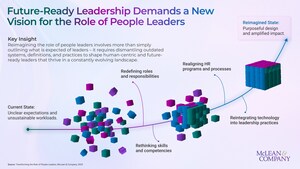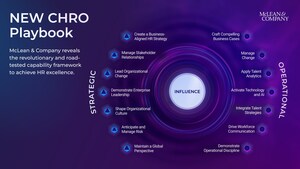
Global HR research and advisory firm McLean & Company has released its new research piece, Guide to Measuring Quality of Hire, at a time when HR leaders face mounting pressure to maximize investments in recruiting while demonstrating the value of talent selection for long-term business outcomes. Despite considerable investment in hiring and onboarding, most organizations lack the metrics to determine whether those hires deliver lasting impact. The new guide provides HR teams with a practical framework to measure quality of hire with confidence, enabling them to strengthen retention, accelerate productivity, and transform hiring into a strategic driver of business performance.
TORONTO, Oct. 16, 2025 /PRNewswire/ - In a competitive labor market, talent can be both the biggest differentiator and the greatest cost. Organizations invest significant resources into hiring and onboarding employees, yet most lack a clear way to measure the quality of hiring decisions. McLean & Company's Guide to Measuring Quality of Hire responds directly to this challenge by offering HR teams a practical framework to measure quality of hire with confidence. Research from the firm's HR Management & Governance Diagnostic Survey (2023-2025) further shows that only 28% of HR leaders view talent acquisition as highly effective in enabling business goals, underscoring the need for a more rigorous, outcomes-focused approach.
According to LinkedIn's 2025 Global Recruiting Trends, 89% of talent acquisition professionals agree that quality of hire measurement is essential to improving recruiting effectiveness and decision-making, yet only 25% report high confidence in their ability to measure it effectively. This gap carries significant costs: US organizations spend an average of 20% of an entry-level salary and more than 200% of an executive salary to replace employees, not including the three to eight months it typically takes new hires to reach productivity (Zippia, 2023).
The firm advises that by defining success criteria, establishing key metrics such as performance, time to productivity, and retention, and involving both HR and business leaders in the process, organizations can turn hiring into a strategic driver of engagement, culture alignment, and long-term business performance.
"Quality of hire is an essential HR metric because it captures the true return on an organization's investments in talent," says Elysca Fernandes, director, HR Research & Advisory Services. "It requires going beyond gut feel and isolated performance reviews to a structured, evidence-based approach that involves HR, managers, and senior leaders."
The new guide provides HR leaders with a two-part framework for operationalizing quality of hire:
- Preparing to Measure: Defining the scope, establishing success criteria, selecting the right post-hire metrics such as performance, retention, and time to productivity, and developing optional quality of hire surveys.
- Measuring and Improving: Creating scorecards, analyzing results to uncover strengths and pain points, communicating insights through storytelling, and translating findings into targeted action plans to improve hiring, onboarding, and development.
Key insights highlighted in the research include the following:
- Shared accountability is essential. HR cannot measure quality of hire in isolation; alignment with business leaders and managers ensures the results drive meaningful change.
- Quality of hire goes beyond a single number. While scorecards are valuable, deeper analysis and segmentation are required to identify root causes of performance gaps and opportunities to scale strengths.
- Action planning closes the loop. Measuring is only the first step; the real business value comes from using insights to refine hiring processes, improve onboarding, and retain new hires.
McLean & Company's Guide to Measuring Quality of Hire also equips HR leaders with practical guidance on defining quality of hire for their organization, sample survey questions and a scorecard, and approaches for adapting their quality of hire measurement plans over time as organizational needs evolve.
By adopting this approach, organizations can shift from reactive talent acquisition to a proactive, strategic function that maximizes the impact of every hire and improves engagement, retention, culture alignment, and overall business performance.
Media Inquiries for HR Analysts and Experts
For media inquiries or to connect with McLean & Company analysts for exclusive, research-backed insights on human resources, crisis management, and how to build resilient, future-ready teams, please contact Communications Manager Katie Tame at [email protected].
To explore practical workshops and advisory support for creating a measurable talent acquisition strategy, visit McLean & Company's Talent Acquisition Strategy Workshop.
About McLean & Company
McLean & Company pairs evidence-based research and immediately applicable tools with deep HR expertise to position organizations to meet today's needs and prepare for the future. The global HR research and advisory firm's member organizations enjoy comprehensive resources, full – service diagnostics, workshops, action plans, and advisory services for all levels of HR professionals, from executive leadership to HR leaders to HR team members, that help shape workplaces where everyone thrives.
McLean & Company is a division of Info-Tech Research Group.
Media professionals can register for unrestricted access to research across IT, HR, and software and hundreds of industry analysts through the firm's Media Insiders program. To gain access, contact [email protected].
SOURCE McLean & Company







Share this article